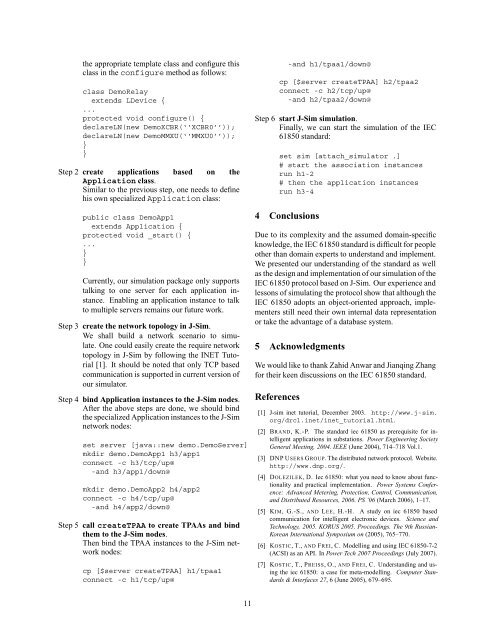Understanding and Simulating the IEC 61850 Standard - CiteSeerX
Understanding and Simulating the IEC 61850 Standard - CiteSeerX
Understanding and Simulating the IEC 61850 Standard - CiteSeerX
Create successful ePaper yourself
Turn your PDF publications into a flip-book with our unique Google optimized e-Paper software.
<strong>the</strong> appropriate template class <strong>and</strong> configure this<br />
class in <strong>the</strong> configure method as follows:<br />
class DemoRelay<br />
extends LDevice {<br />
...<br />
protected void configure() {<br />
declareLN(new DemoXCBR(‘‘XCBR0’’));<br />
declareLN(new DemoMMXU(‘‘MMXU0’’));<br />
}<br />
}<br />
Step 2 create applications based on <strong>the</strong><br />
Application class.<br />
Similar to <strong>the</strong> previous step, one needs to define<br />
his own specialized Application class:<br />
public class DemoApp1<br />
extends Application {<br />
protected void _start() {<br />
...<br />
}<br />
}<br />
Currently, our simulation package only supports<br />
talking to one server for each application instance.<br />
Enabling an application instance to talk<br />
to multiple servers remains our future work.<br />
Step 3 create <strong>the</strong> network topology in J-Sim.<br />
We shall build a network scenario to simulate.<br />
One could easily create <strong>the</strong> require network<br />
topology in J-Sim by following <strong>the</strong> INET Tutorial<br />
[1]. It should be noted that only TCP based<br />
communication is supported in current version of<br />
our simulator.<br />
Step 4 bind Application instances to <strong>the</strong> J-Sim nodes.<br />
After <strong>the</strong> above steps are done, we should bind<br />
<strong>the</strong> specialized Application instances to <strong>the</strong> J-Sim<br />
network nodes:<br />
set server [java::new demo.DemoServer]<br />
mkdir demo.DemoApp1 h3/app1<br />
connect -c h3/tcp/up@<br />
-<strong>and</strong> h3/app1/down@<br />
mkdir demo.DemoApp2 h4/app2<br />
connect -c h4/tcp/up@<br />
-<strong>and</strong> h4/app2/down@<br />
Step 5 call createTPAA to create TPAAs <strong>and</strong> bind<br />
<strong>the</strong>m to <strong>the</strong> J-Sim nodes.<br />
Then bind <strong>the</strong> TPAA instances to <strong>the</strong> J-Sim network<br />
nodes:<br />
cp [$server createTPAA] h1/tpaa1<br />
connect -c h1/tcp/up@<br />
-<strong>and</strong> h1/tpaa1/down@<br />
cp [$server createTPAA] h2/tpaa2<br />
connect -c h2/tcp/up@<br />
-<strong>and</strong> h2/tpaa2/down@<br />
Step 6 start J-Sim simulation.<br />
Finally, we can start <strong>the</strong> simulation of <strong>the</strong> <strong>IEC</strong><br />
<strong>61850</strong> st<strong>and</strong>ard:<br />
set sim [attach_simulator .]<br />
# start <strong>the</strong> association instances<br />
run h1-2<br />
# <strong>the</strong>n <strong>the</strong> application instances<br />
run h3-4<br />
4 Conclusions<br />
Due to its complexity <strong>and</strong> <strong>the</strong> assumed domain-specific<br />
knowledge, <strong>the</strong> <strong>IEC</strong> <strong>61850</strong> st<strong>and</strong>ard is difficult for people<br />
o<strong>the</strong>r than domain experts to underst<strong>and</strong> <strong>and</strong> implement.<br />
We presented our underst<strong>and</strong>ing of <strong>the</strong> st<strong>and</strong>ard as well<br />
as <strong>the</strong> design <strong>and</strong> implementation of our simulation of <strong>the</strong><br />
<strong>IEC</strong> <strong>61850</strong> protocol based on J-Sim. Our experience <strong>and</strong><br />
lessons of simulating <strong>the</strong> protocol show that although <strong>the</strong><br />
<strong>IEC</strong> <strong>61850</strong> adopts an object-oriented approach, implementers<br />
still need <strong>the</strong>ir own internal data representation<br />
or take <strong>the</strong> advantage of a database system.<br />
5 Acknowledgments<br />
We would like to thank Zahid Anwar <strong>and</strong> Jianqing Zhang<br />
for <strong>the</strong>ir keen discussions on <strong>the</strong> <strong>IEC</strong> <strong>61850</strong> st<strong>and</strong>ard.<br />
References<br />
[1] J-sim inet tutorial, December 2003. http://www.j-sim.<br />
org/drcl.inet/inet_tutorial.html.<br />
[2] BRAND, K.-P. The st<strong>and</strong>ard iec <strong>61850</strong> as prerequisite for intelligent<br />
applications in substations. Power Engineering Society<br />
General Meeting, 2004. IEEE (June 2004), 714–718 Vol.1.<br />
[3] DNP USERS GROUP. The distributed network protocol. Website.<br />
http://www.dnp.org/.<br />
[4] DOLEZILEK, D. Iec <strong>61850</strong>: what you need to know about functionality<br />
<strong>and</strong> practical implementation. Power Systems Conference:<br />
Advanced Metering, Protection, Control, Communication,<br />
<strong>and</strong> Distributed Resources, 2006. PS ’06 (March 2006), 1–17.<br />
[5] KIM, G.-S., AND LEE, H.-H. A study on iec <strong>61850</strong> based<br />
communication for intelligent electronic devices. Science <strong>and</strong><br />
Technology, 2005. KORUS 2005. Proceedings. The 9th Russian-<br />
Korean International Symposium on (2005), 765–770.<br />
[6] KOSTIC,T.,AND FREI, C. Modelling <strong>and</strong> using <strong>IEC</strong> <strong>61850</strong>-7-2<br />
(ACSI) as an API. In Power Tech 2007 Proceedings (July 2007).<br />
[7] KOSTIC,T.,PREISS, O., AND FREI, C. <strong>Underst<strong>and</strong>ing</strong> <strong>and</strong> using<br />
<strong>the</strong> iec <strong>61850</strong>: a case for meta-modelling. Computer St<strong>and</strong>ards<br />
& Interfaces 27, 6 (June 2005), 679–695.<br />
11
















